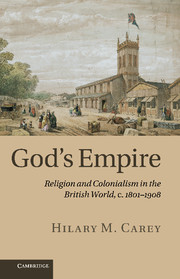Book contents
- Frontmatter
- Contents
- List of figures
- List of maps
- List of tables
- Preface and acknowledgments
- List of abbreviations
- Maps
- Part I God's empire
- Part II Colonial missionary societies
- Part III Colonial clergy
- 8 Clergy
- 9 St Augustine's College, Canterbury
- 10 Missionary College of All Hallows, Drumcondra (Dublin)
- Part IV Promised lands
- Conclusion
- Bibliography
- Index
9 - St Augustine's College, Canterbury
Published online by Cambridge University Press: 04 February 2011
- Frontmatter
- Contents
- List of figures
- List of maps
- List of tables
- Preface and acknowledgments
- List of abbreviations
- Maps
- Part I God's empire
- Part II Colonial missionary societies
- Part III Colonial clergy
- 8 Clergy
- 9 St Augustine's College, Canterbury
- 10 Missionary College of All Hallows, Drumcondra (Dublin)
- Part IV Promised lands
- Conclusion
- Bibliography
- Index
Summary
The most visible sign of the revival of aspirations for the national Church in the colonies was the creation of the Colonial Bishoprics' Fund in 1841. With the fund in place, it was possible for the Church to move almost immediately to the erection of a vastly expanded colonial episcopate and escape from its dependence on the missionary societies for personnel and policy. Cnattingius identifies the 1840s as an epoch-making period in what he calls ‘the evolution of Anglicanism into a World Church. The heads of the Church of England had shown that, as builders of a spiritual empire, they were worthy to take their place beside the builders of the political empire.’ However, as the Evangelicals in the Colonial Missionary Society were fond of pointing out, there was little point in sending out bishops to colonial dioceses where there was no church for them to administer. It was exciting to create new bishops in unprecedented numbers for the Anglican world. The Colonial Church Chronicle exulted in reporting the elaborate service held in Westminster Abbey on 29 June 1847 for the consecration of William Tyrrell, bishop of Newcastle, New South Wales, Augustus Short, bishop of Adelaide, Charles Perry, bishop of Melbourne, and Robert Gray, bishop of Cape Town. Bishops, however, if they are to be effective, must have clergy, and where were these to come from? The establishment of four new colonial bishoprics (and many more were to follow) immediately put considerable pressure on the available supply.
- Type
- Chapter
- Information
- God's EmpireReligion and Colonialism in the British World, c.1801–1908, pp. 271 - 286Publisher: Cambridge University PressPrint publication year: 2011



